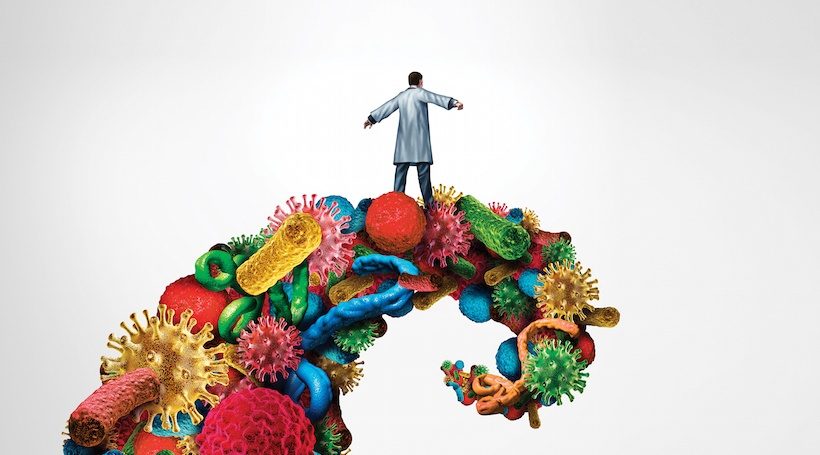You can’t trust your family’s health to potentially misleading or false information, so we asked some SJ cancer doctors to separate fact from fiction.
MYTH: Your cell phone is giving you cancer
It’s the first thing many of us reach for each morning and the last thing we look at before going to sleep, so it’s no wonder many people question whether there’s a direct link between increased cell phone usage and cancer rates.
“I hear this question from a number of patients, specifically wanting to know if their cell phone increases their risk of brain cancer,” says Rachel Levenbach, MD, of Regional Cancer Care Associates Mount Holly.
Many people wonder if the radiofrequency waves emitted by cell phones can lead to brain tumors or other tumors in the head and neck area.
“There’s not any evidence at this point that cell phones cause cancer,” Levenbach says, noting the majority of studies published have failed to show an association between exposure to radiofrequency from a cell phone and health problems.
“In terms of cause, brain cancer is generally genetic,” Levenbach says. It’s also fairly rare – fewer than five brain cancer cases for every 100,000 people under 65 are diagnosed each year, according to the National Cancer Institute.
Cell phone use aside, Levenbach urges anyone who has symptoms of a brain tumor – changes in behavior or vision accompanied by nausea, vomiting or loss of balance – to act quickly.
“There’s no screening test for patients,” she says, but if you notice any of those symptoms, “receive a medical exam, whether it’s by your primary care doctor or an oncologist.”
MYTH: Cancer isn’t contagious
We all know cancer can’t spread person to person like a cold or the flu – but you may not know that some cancers can be caused by certain highly contagious viruses.
Those viruses – hepatitis C, Epstein-Barr and human papillomavirus (HPV), for example – are known to directly cause mutations in DNA that can develop into cancer.
“The viruses are a constant presence in the body. They cause chronic inflammation, and that leads to changes in the cellular structure that can transform normal cells into cancer cells,” says Eduardo Fernandez, MD, director of medical oncology at Lourdes Health System.
The most common is HPV – a whopping 79 million Americans are currently infected with it, according to the CDC. In fact, the virus is so widespread that most sexually active men and women will get at least one type of it at some point in their lives.
HPV is also the primary cause of the development of cervical cancer in women, says Fernandez.
“The virus is spread by sexual contact, but most people with HPV never develop symptoms, so they’re unaware they’re infected,” he says. “There’s also no cure for it – once you get HPV, you always have it.”
Because of the constant cancer threat from HPV, Fernandez says there’s been a big push to vaccinate young adults against the virus before they become sexually active.
“The newer vaccines can prevent most types of HPV,” he says. “If you can prevent the viral infection, theoretically, you can prevent almost all cases of cervical cancer.”
MYTH: Only fair-skinned people are at risk for skin cancer
Trina Poretta, DO, medical director of Kennedy Cancer Center, notes that people of any skin tone or race can still get sunburned, and anyone who’s had a sunburn with blistering and peeling – even just once – is at risk for skin cancer.
“This myth probably developed from the fact that pale people burn easily,” says Poretta. “But all skin cancers are related to sun exposure, and everyone is exposed to the sun.”
When people believe their risk of skin cancer is lower – or even that they’re immune to it – because of their skin color, it often delays treatment and can make skin cancer deadlier, according to the Skin Cancer Foundation.
“That’s why it’s important to have routine dermatology visits, even if they’re once a year,” says Poretta.
Self-examinations are also important, she adds. “A mole changing in size, developing irregular borders or suddenly bleeding is always a concern. Know your body and know when things change so you can get help right away.”
MYTH: Eating superfoods can ward off cancer
There’s loads of evidence that proves eating a healthy diet is instrumental in keeping many diseases and illnesses – including cancer – at bay, but that doesn’t mean it’s a one-way ticket to perfect health.
“I see this often – people think if they eat the right things that they can’t get cancer,” says Lourdes’ Fernandez.
Research has shown that superfoods like blueberries, broccoli, tomatoes and grapefruit contain phytochemicals that help cells stop and wipe out cancer-like changes. The American Cancer Society recommends eating at least five servings of fruits and veggies each day, but that doesn’t mean there’s a secret cancer defense hiding in the produce aisle.
“After some of my patients have been diagnosed with cancer, they’ll say how they stayed away from growth hormones in their food, ate only grass-fed beef, never forgot their vitamins. They’re amazed they developed cancer,” adds Fernandez. “I tell them that though a healthy diet helps lower your risk, it doesn’t eliminate it.”
MYTH: The scale doesn’t weigh your cancer risk
The proof is in the numbers: a higher number on the scale may indicate you have more body fat than recommended, and a higher percentage of body fat puts you at risk for cancer.
“We do know that obesity can increase your risks of certain cancers,” Regional Cancer Care Associates’ Levenbach says. “The likelihood of getting breast cancer, in particular, is higher if you’re obese.”
Being overweight or obese is also linked with an increased risk of cancers in the colon and rectum, endometrium (lining of the uterus), esophagus, kidney and pancreas, according to the American Cancer Society.
The World Cancer Research Fund estimates that roughly 20 percent of all cancers diagnosed in the United States are related to body fat, physical inactivity, excess alcohol consumption and/or poor nutrition. Furthermore, excess body weight contributes to as many as one out of five of all cancer-related deaths.
“In general, a healthy lifestyle can go a long way,” Levenbach says. “You want to be exercising and eating healthy, not just to help with cancer, but also to be good to the rest of your body.”














